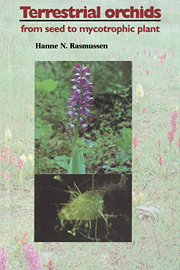Book contents
- Frontmatter
- Contents
- Acknowledgements
- Introduction
- 1 Properties of ‘dust’ seeds
- 2 Seed development
- 3 Seed survival
- 4 Requirements for germination
- 5 Fungi
- 6 Germination processes
- 7 Underground organs
- 8 Orchid mycorrhiza
- 9 Abiotic factors in growth and development
- 10 Life history and phenology
- 11 Propagation
- 12 Effects of orchid mycorrhiza
- 13 Descriptions of genera
- Appendix A Nutrient substrates mentioned in the text
- Appendix B Names and synonyms
- References
- Index
4 - Requirements for germination
Published online by Cambridge University Press: 13 October 2009
- Frontmatter
- Contents
- Acknowledgements
- Introduction
- 1 Properties of ‘dust’ seeds
- 2 Seed development
- 3 Seed survival
- 4 Requirements for germination
- 5 Fungi
- 6 Germination processes
- 7 Underground organs
- 8 Orchid mycorrhiza
- 9 Abiotic factors in growth and development
- 10 Life history and phenology
- 11 Propagation
- 12 Effects of orchid mycorrhiza
- 13 Descriptions of genera
- Appendix A Nutrient substrates mentioned in the text
- Appendix B Names and synonyms
- References
- Index
Summary
Under suitable aeration and temperature conditions non-dormant plant seeds need only access to water to be able to germinate, but since orchid seedlings are heterotrophic to varying degrees their seeds often have several requirements from outside besides water. These are undoubtedly met by the endophyte when germination takes place in nature, or indirectly by the substrate that the fungus lives on.
Some other requirements for germination of orchid seeds are associated with dormancy. The currently available evidence suggests that several types of dormancy, both exogenous and endogenous, occur in the seeds of holarctic orchids. In spite of the apparently delicate nature of the translucent testa its impermeability to water represents a form of physical dormancy that can be overcome by prolonged soaking or by scarification. There are different types of physiological dormancy that can be broken by darkness, temperature regime, atmospheric conditions, or certain external chemical signals. Finally, morphological dormancy, expressed as a requirement for the embryos to after-ripen, probably also occurs in orchid seeds.
The treatments and substrate additives that are necessary to obtain germination in vitro can thus be divided into those that are needed for seeds to germinate in symbiotic culture, i.e. such that break dormancy, and the more extensive set of conditions that must be met if the seeds are to germinate asymbiotically. The difference between these sets would seem to directly represent the effects of the fungus, but this conclusion may not be valid, since several external stimuli may elicit the same physiological response, for instance when different metabolites influence different steps in the same group of reactions.
- Type
- Chapter
- Information
- Terrestrial OrchidsFrom Seed to Mycotrophic Plant, pp. 39 - 76Publisher: Cambridge University PressPrint publication year: 1995

